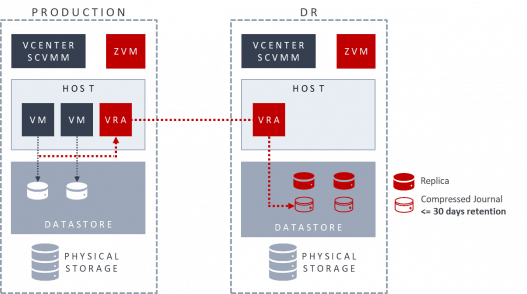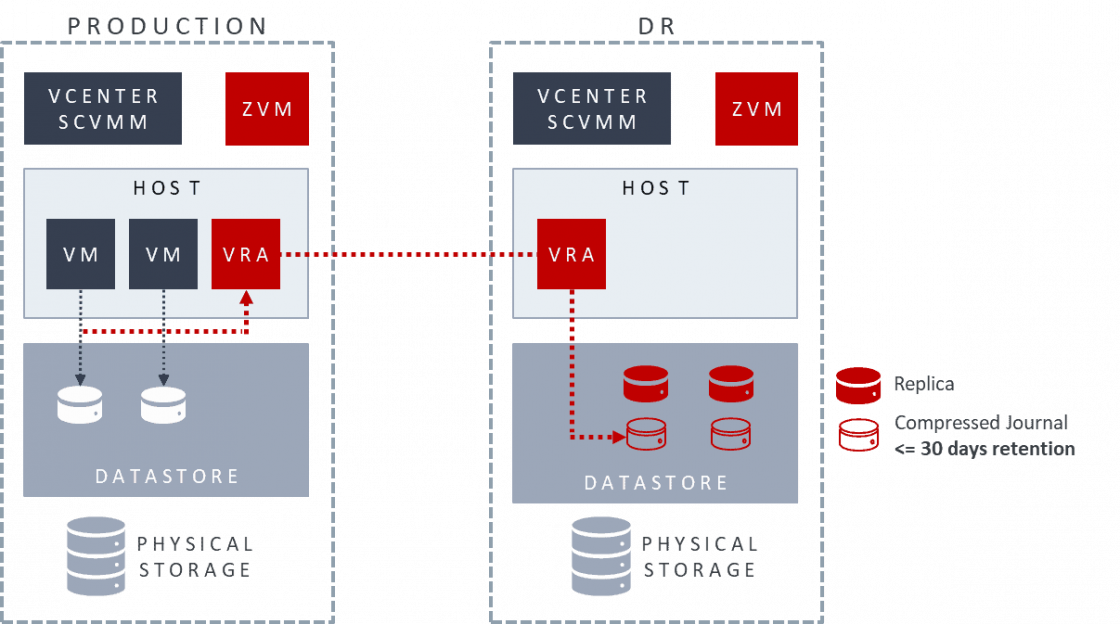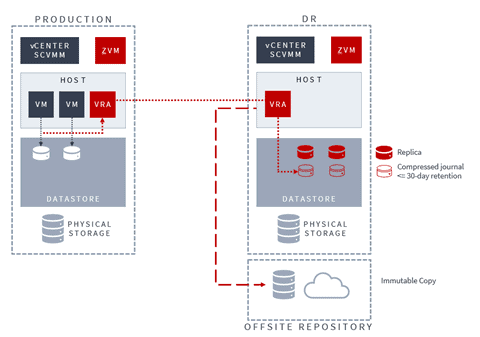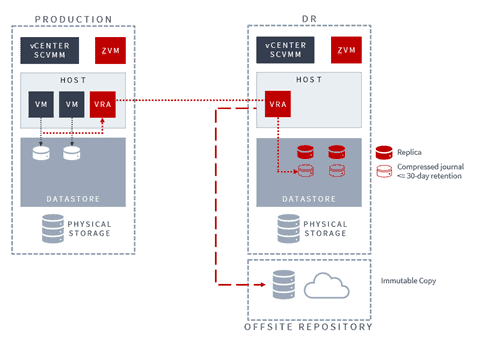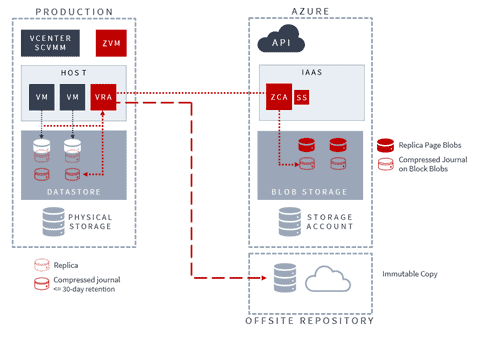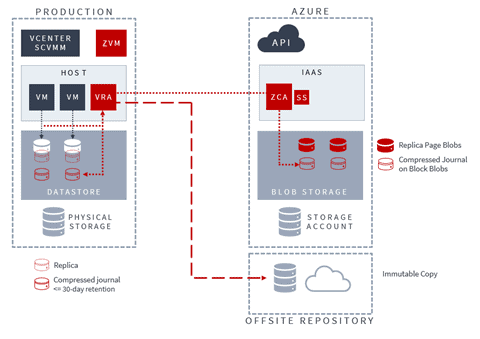Zerto Reference Architectures
Get a glimpse of how Zerto can deliver ransomware resilience—including detection and recovery— disaster recovery, and multi-cloud mobility
Zerto's Architecture Guide
For anyone designing for backup, disaster recovery, and data mobility with Zerto.
Solving for Disaster Recovery, Ransomware Resilience, and Data Mobility
Zerto’s software-only solution delivers disaster recovery (DR), ransomware resilience, and data mobility across on-premises, cloud, and hybrid environments.

Disaster Recovery
Recover one, all, or a subset of virtualized application from anywhere to anywhere. Zerto includes replication, ransomware detection, recovery orchestration and automation in one simple software solution.
Zerto not only allows replication and recovery between any storage, but also protects across and between hypervisors and public cloud platforms. This delivers a best-of-breed business continuity/disaster recovery (BCDR) solution regardless of underlying hypervisor, public cloud, or storage.
Ransomware Resilience
Detect ransomware in real-time with Zerto. As Zerto replicates data, intelligent analyzers inspect the data to look for anomalous encryption. This unique proprietary approach gives you the earliest warning system to alert security teams immediately if an attack is likely underway.
With near real-time data replication, Zerto rapidly rewinds and recovers to a clean state just second before an attack, so you can resume operations in minutes with fully automated and orchestrated recovery.

Multi-Cloud Mobility & Migrations
Move applications to, from, and between multiple platforms, whether on-premises or cloud, with minimal business impact and no traditional infrastructure constraints. Zerto removes the traditional lock-in to these platforms and includes the ability to validate mobility prior to the live event without production impact.
With Zerto's always-on replication engine, you can accelerate your datacenter consolidation or cloud migration projects with speed and power.
Supported Use Cases
Outages & Disruptions
Any disruption on the production site—whether to power, network, or another system—is protected. Zerto recovers your files and folders, VMs, applications or site within just a few minutes to a point in time just seconds before the issue occurred.
Ransomware Attacks
Zerto helps you detect ransomware in real-time and recover from attacks. Easy rollback to just seconds before encryption minimizes data loss and business impact. You can recover your files and folders, VMs, applications, or entire sites without paying a penny in ransom. Zerto's fully automated and orchestrated recovery ensures your organization is back and running quickly.
Infrastructure Modernization
This same architecture can be used to move your workloads from an end-of-life platform to your new infrastructure in just minutes, significantly speeding up infrastructure modernization projects.
Consolidations & Migrations
If you want to consolidate or migrate multiple sites to the same target, this architecture can be used to streamline the process. The architecture enables pre-migration testing and live migration times of just minutes.
Testing & DevOps
Zerto allows the creation of instant, on-demand development and testing envrionments at a remote site. With testing and DevOps, you can get an exact copy of your production environment from any point in time. This not only provides greater flexibility for your development teams and reduces DevOps overhead but also enables DR testing and validation.
Analytics across Clouds
A single, secure, SaaS-based analytics solution provides complete data analysis across all your sites, whether on-premises or in the cloud. Zerto's single view simplifies management and monitoring without added cost.
Disaster Recovery with a Single Remote Target
In a single remote target architecture, protected VMs are grouped in virtual protection groups (VPGs) with VM-level consistency. A remote journal is configured on the target site and used for short-term recovery scenarios where recovery granularity of just seconds can be achieved.
The minimum recommended history period for this journal is eight days as this will cover most recovery scenarios, including ransomware. All changes on the protected VMs are then kept for eight days before promotion to the remote replica disk(s).
Components of Zerto
Learn More About This Architecture
Local Continuous Replication and Disaster Recovery
This reference architecture takes the previous DR reference architecture and adds both a local journal and an extended journal repository, which uses cost-effective public cloud storage for immutable off-site copies.
The local journal provides a continuous replication capability, allowing you to instantly restore files, VMs, or applications locally with the granularity of seconds, ensuring minimal data loss from a disruption.
The immutable copy helps you store data beyond the journal history for up to one year and provides a virtual, air-gapped copy immune to ransomware and accidental deletion.
Learn More About This Architecture
Local Continuous Replication and Public Cloud Disaster Recovery
This reference architecture is similar to the “local continuous replication and disaster recovery” model, but the remote target here is the public cloud.
In this configuration, two journals are created: one on the source, and one on the remote public cloud target. This cloud journal is placed on blob storage in Azure or an S3 bucket in AWS and is configured on the cloud side. This eliminates idle compute cost with compute requirements only spun up in a recovery scenario.
Additional Use Cases
Cloud Integration & Migration: Move workloads to your chosen cloud platform in just minutes with zero data loss.
Multi-Cloud/Hybrid Cloud: Move workloads around on demand and with freedom as requirements change.
Learn More About this Architecture
Not Seeing Your Own Use Case?
Get in touch with us so that we can go over your specific scenario and help you see how Zerto will let you achieve your goals.
Hands-on Labs
Want to give Zerto a try? Get access to our free on-demand labs, where you can try out many Zerto features with guided instruction.
